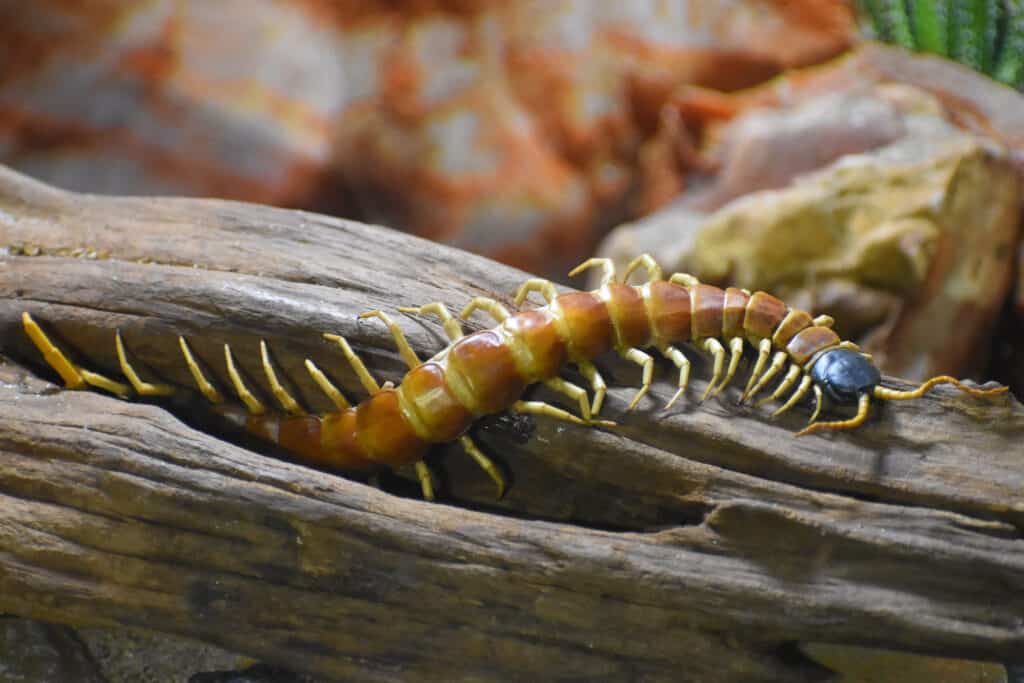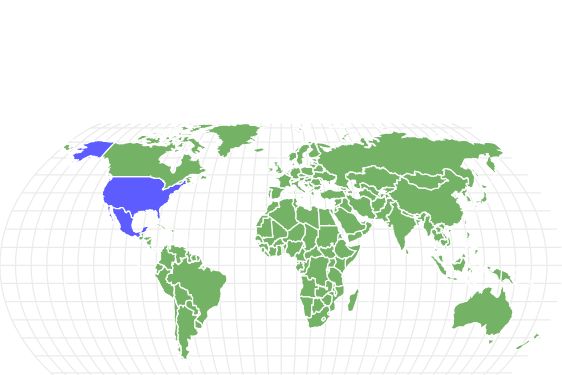Giant Desert Centipede
Scolopendra heros
They are the largest centipede in North America
Advertisement
Giant Desert Centipede Scientific Classification
- Kingdom
- Animalia
- Phylum
- Arthropoda
- Class
- Chilopoda
- Order
- Scolopendromorpha
- Family
- Scolopendridae
- Genus
- Scolopendra
- Scientific Name
- Scolopendra heros
Read our Complete Guide to Classification of Animals.
Giant Desert Centipede Conservation Status
Giant Desert Centipede Facts
- Prey
- Arthropods, vertebrates, insects
- Group Behavior
- Solitary
- Fun Fact
- They are the largest centipede in North America
- Most Distinctive Feature
- Changes color to warn predator
- Other Name(s)
- Other names Giant Sonoran Centipede, Texas Redheaded Centipede, and Giant Redheaded Centipede
- Gestation Period
- 2 months
- Litter Size
- 12 to 60 eggs
- Habitat
- Rocky woodlands
- Diet
- Carnivore
- Lifestyle
- Nocturnal
- terrestrial
- Favorite Food
- small insects, toads, rodents, and small snakes, moths
- Common Name
- Giant Desert Centipede
- Number Of Species
- 1
- Location
- United States(Arkansas, Southern Missouri, Louisiana, Kansas, Oklahoma, Texas, New Mexico, Arizona), Mexico
Giant Desert Centipede Physical Characteristics
- Color
- Black
- Green
- Orange
- Lifespan
- 5 years
- Length
- 6-8 inches
- Venomous
- Yes
- Aggression
- Medium
View all of the Giant Desert Centipede images!
The Giant Desert Centipede is the largest centipede in Northern America.
Summary
The Giant Desert Centipede is only found in two major regions but it is known by different names around the world. It is often mistaken for the Desert Centipede, which is a relative, but they both have distinct features that are different from each other.
Species, Types, and Scientific name
Giant Desert Centipede is referred to as the Scolopendra heros in the scientific world. Its origin is Latin, and it was named by Girard in 1853. It belongs to the order Scolopendromorpha and the family Scolopendridae.
The species has a lot of different names like Giant Desert Centipede, Giant Sonoran Centipede, Texas Redheaded Centipede, and Giant Redheaded Centipede. There are more than 8,000 species of centipede in the world but, the population size of the Giant Desert Centipede is yet to be known.
They are venomous centipedes, which are the largest in North America. Their population is restricted to only Mexico and some parts of the United States. Although their population is limited, they do not have any special conservation status.
They only have one species, named the Giant Desert Centipede.
Appearance: How To Identify Giant Desert Centipede?
Eggs
Around 12 to 60 eggs are laid by a female in one reproductive cycle. They remain in clusters in concealed spaces, under protection from the female Giant Desert Centipede. The females usually lay these eggs in either autumn or summer. She stays on guard until the hatchlings have had their second molting episode.
Instar
The babies hatch from their eggs after two months. And the hatchlings are more or less the same in their physical attributes as that of an adult. The number of segments is the same throughout its whole life that can carry on for nearly a decade.
However, it does go through the process of molting to shed its exoskeleton. After molting, they enter a new stage known as an instar. This process repeats a few times until they are old enough to mate.
Adult
A Giant Desert Centipede measures up to 6.5 inches but it can cross 8 inches if it is out in the wild. It is the largest centipede in North America.
Their head is flattened and round in shape and has a segmented body. Their head bears a pair of antennae that helps them navigate through their surroundings. This is because they do not have any eyes.
Their head is sometimes orange in color along with the first part of their segmented body. That is why they are sometimes called “Giant Redheaded Centipede” or “Texas Redheaded Centipede” in various regions. But they exist in different colors.
When it comes to their body, they have around 26 to 30 segments, each carrying a pair of legs. However, it is hard to determine which end is the mouth and which end is the tail, at times. Their legs are usually yellow and their bodies are often greenish black. They have a pair of elongated mandibles and two pairs of maxillae that can be used to pinch.
Each centipede has around 20 pairs of legs and a set of hind legs at the back of its body. In total, they may have 21 to 23 pairs of legs. Their front limbs have injectors that carry venom inside that can help to bring the prey down.

The giant desert centipede is the largest centipede in North America.
©Laura Ekleberry/Shutterstock.com
Their biggest survival instinct is their venomous legs. In addition, they display aposematism. This is a general phenomenon where an animal changes its color to warn the predator that they are poisonous. Since this centipede carries venom in its legs, it warns its predator by changing its color. This keeps both the prey and the predator safe from potential harm.
They are nocturnal in nature. You can find them hiding during the day and coming out to hunt at night. In addition, although they are poisonous, they are only slightly aggressive.
Habitat: Where to find Giant Desert Centipede
The Giant Desert Centipede is found only in two countries but its population is quite widespread. Some of the main regions where it is located are Arkansas, Southern Missouri, Louisiana, Kansas, Oklahoma, Texas, New Mexico, Arizona, and Northern Mexico.
They can take residence in any place where there is shelter. They stay hidden in the warmer seasons and are often seen out during cloudy weather.
You can spot them in rocky woodlands, under rocks, potted plants, decayed wood spaces, and such. They tend to lay eggs under rocks or in concealed spaces so they usually stay hidden. Since they are nocturnal, you can only find them at night trying to hunt down their prey.
The Venom Of Giant Desert Centipede: How Dangerous Is It?
The Giant Desert Centipede is slightly aggressive in nature. Although it is venomous, its venom is only used to subdue its prey. The venom is capable of paralyzing the nervous system of insects and making it difficult for them to escape. The same goes for smaller vertebrates.
As for other vertebrates like humans, the venom has had different effects. A rat showed it was in incredible pain after the sting of the Giant Desert Centipede but went back to its normal state after a few hours.
Similarly, when it attacked humans, the bite only caused swelling and sharp pain. This went away after a few hours and it has not produced any fatalities or deaths to date. Now, the venom of the Giant Desert Centipede has not been studied in detail much because it disintegrates quickly. But it has not shown to be much danger.
Diet: What do Giant Desert Centipedes Eat?
Giant Desert Centipede are carnivorous in nature. They use venom to hunt down their prey but can also reach out in the air to feed on small insects. The centipedes are capable of eating small amphibians and vertebrates because of their larger size.
What Does It Eat?
A Giant Desert Centipede may eat small insects, toads, rodents, and small snakes, and may feed on moths if kept in captivity.
What Eats Giant Desert Centipede?
Their predators include owls, coyotes, ringtails, bobcats, and badgers.
Prevention: How do I get rid of Giant Desert Centipedes?
The best advice for the Giant Desert Centipede would be to not bother them unless they bother you. This is because if they are provoked, they will be forced to bite you. But if you do come across one hiding out in your home, it is best to steer clear.
A good rule of thumb is that it is best to set out precautionary measures. The pinch of the Giant Desert Centipede might not be fatal but it is extremely painful, nonetheless. So, here are the prevention tips that you need;
- Ventilate all the moist spaces around your house because the Giant Desert Centipede prefers the humid environment.
- Seal all the gaps, crevices, holes, and cracks inside your home and especially the basements and bathrooms.
- Remove all compost piles, firewood, and fallen logs because this is where centipedes usually reside.
- Eradicate all other insects that might be a food source for these centipedes.
Up Next …
Centipede vs. Silverfish: What are the Differences?
Caterpillar vs. Centipede: What’s the Difference?
Are Centipedes Poisonous or Dangerous?
Giant Desert Centipede FAQs (Frequently Asked Questions)
Are Giant Desert Centipedes dangerous?
No, they are not dangerous. They do have a poisonous venom but it is more on the defensive side than the offensive.
How many legs does the Giant Desert Centipede have?
It has 21 to 23 pairs of legs.
How painful is a giant desert centipede?
The Giant Desert Centipede is somewhat dangerous. If it is provoked, it will bite you and the pain can be sharp for a few hours. You may also experience swelling.
How big is the giant desert centipede?
It can measure up to 6 to 8 inches.
How fast is a giant desert centipede?
They are pretty fast. A Giant Desert Centipede can travel 1.1 to 3 feet per second.
How do you identify the Giant Desert Centipede?
They are greenish-black in color with a red head and around 6-8 inches.
Thank you for reading! Have some feedback for us? Contact the AZ Animals editorial team.
Sources
- Wikipedia / Accessed August 1, 2022
- Family Handyman / Accessed August 1, 2022
- Orkin / Accessed August 1, 2022
- MDC / Accessed August 1, 2022
- Terminix / Accessed August 1, 2022


















